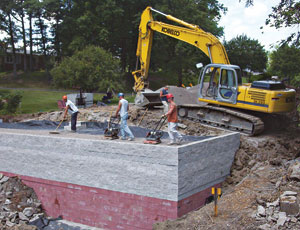Warren Schlatter, county engineer for Defiance County, Ohio, recalls his staff’s initial reaction when Michael Adams, Federal Highways Administration research geotechnical engineer, told them about using geosynthetic-reinforced soil technology to replace bridge abutments faster and cheaper. “We were a bit skeptical,” he says. “Could our crews do it? Would it work?” It has. Since 2005, Schlatter’s crews have built almost 20 structures.

“He had faith in us,” says Adams, who since the 1990s has been working on what now is FHWA’s GRS Integrated Bridge System program. It has been a long struggle to get conservative engineers to accept the technology, but “it’s a fight that’s worth it.” The concept is simple: alternate local soil with sheets of geotextiles to create a composite-acting material, contained by concrete blocks. “The more I investigated it, the more it impressed me,” Adams says. “Every time we did experiments, it exceeded our expectations.”
Adams first experimented with GRS on bridge footings. He moved on to piers and walls, doing field tests with the Colorado Dept. of Transportation and University of Colorado, then a full-scale pier at the Turner-Fairbank Highway Research Center. He credits FHWA for believing in and funding his work even during the years of hard sell. Now engineers in other Ohio counties and several states are expressing interest.

In a tireless crusade, Adams has promoted the use of geosynthetic-reinforced soil methods for faster, cheaper bridge components.
“Mike Adams’ commitment to excellence and innovation epitomizes the reason for FHWA’s highway research programs,” says FHWA Administrator Tom Madison. “He is continuing the agency’s scientific tradition that improves motorist safety and saves taxpayers billions of dollars in the process.”



Post a comment to this article
Report Abusive Comment